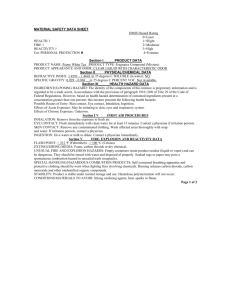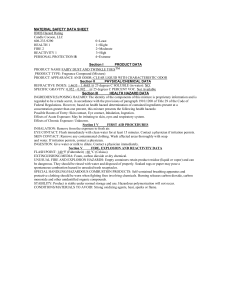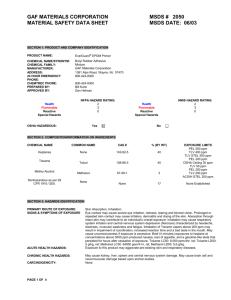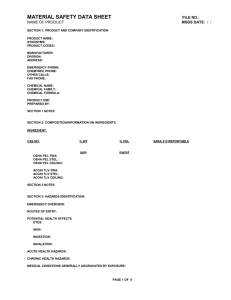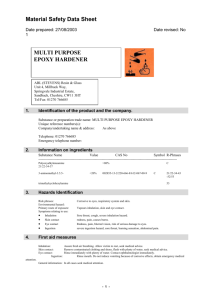msds: itecsol™ - anhydrous isopropyl alcohol mixture
advertisement
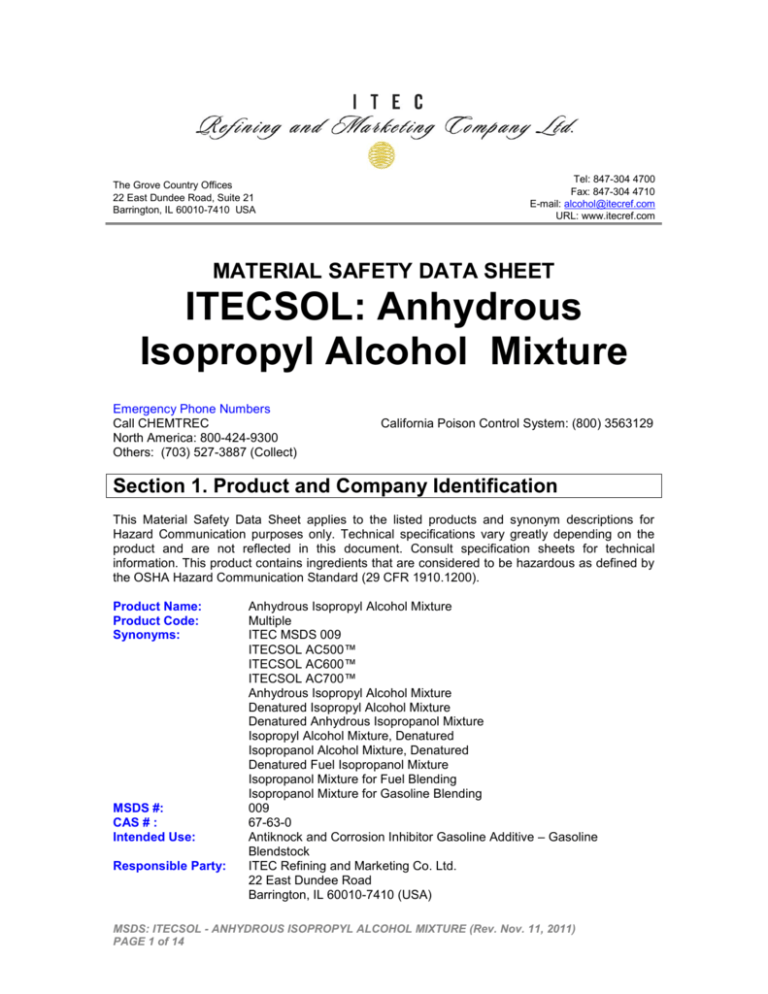
The Grove Country Offices 22 East Dundee Road, Suite 21 Barrington, IL 60010-7410 USA Tel: 847-304 4700 Fax: 847-304 4710 E-mail: alcohol@itecref.com URL: www.itecref.com MATERIAL SAFETY DATA SHEET ITECSOL: Anhydrous Isopropyl Alcohol Mixture Emergency Phone Numbers Call CHEMTREC North America: 800-424-9300 Others: (703) 527-3887 (Collect) California Poison Control System: (800) 3563129 Section 1. Product and Company Identification This Material Safety Data Sheet applies to the listed products and synonym descriptions for Hazard Communication purposes only. Technical specifications vary greatly depending on the product and are not reflected in this document. Consult specification sheets for technical information. This product contains ingredients that are considered to be hazardous as defined by the OSHA Hazard Communication Standard (29 CFR 1910.1200). Product Name: Product Code: Synonyms: MSDS #: CAS # : Intended Use: Responsible Party: Anhydrous Isopropyl Alcohol Mixture Multiple ITEC MSDS 009 ITECSOL AC500™ ITECSOL AC600™ ITECSOL AC700™ Anhydrous Isopropyl Alcohol Mixture Denatured Isopropyl Alcohol Mixture Denatured Anhydrous Isopropanol Mixture Isopropyl Alcohol Mixture, Denatured Isopropanol Alcohol Mixture, Denatured Denatured Fuel Isopropanol Mixture Isopropanol Mixture for Fuel Blending Isopropanol Mixture for Gasoline Blending 009 67-63-0 Antiknock and Corrosion Inhibitor Gasoline Additive – Gasoline Blendstock ITEC Refining and Marketing Co. Ltd. 22 East Dundee Road Barrington, IL 60010-7410 (USA) MSDS: ITECSOL - ANHYDROUS ISOPROPYL ALCOHOL MIXTURE (Rev. Nov. 11, 2011) PAGE 1 of 14 Section 2. Hazards Identification Danger! Can cause kidney, liver and blood disorders. May cause irritation to eyes, skin and respiratory system. Avoid liquid, mist and vapor contact. Harmful or fatal if swallowed. Aspiration hazard; can enter lungs and cause damage. May cause irritation or be harmful if inhaled or absorbed through the skin. Extremely flammable liquid. Vapors may explode. Physical state: Liquid. Emergency Overview: Danger! FLAMMABLE LIQUID AND VAPOR. CONTAINS MATERIAL THAT CAN CAUSE TARGET ORGAN DAMAGE. POSSIBLE CANCER HAZARD CONTAINS MATERIAL WHICH MAY CAUSE CANCER, BASED ON ANIMAL DATA. Do not ingest. Avoid prolonged contact with eyes, skin and clothing. Keep away from heat, sparks and flame. Keep container closed. Use only with adequate ventilation. Wash thoroughly after handling. Risk of cancer depends on duration and level of exposure. Routes of entry: Dermal contact. Eye contact. Inhalation. Ingestion. Potential acute health effects: Eyes: Excessive exposure (400 ppm) to isopropanol may cause eye, nose and throat irritation. Incoordination, confusion, hypertension, hyperthermia, circulatory collapse, respiratory arrest and death may follow a longer duration or higher levels. Observations in animals include middle ear lining damage upon exposure to vapors of isopropanol. However, the relevance of this to humans is unknown. Skin: Prolonged or repeated contact may cause moderate irritation, defatting (cracking),redness, itching, inflammation, dermatitis and possible secondary infection. High pressure skin injections are SERIOUS MEDICAL EMERGENCIES. Injury may not appear serious at first. Within a few hours, tissues will become swollen, discolored and extremely painful. Inhalation: Nasal and respiratory tract irritation, central nervous system effects including excitation, euphoria, contracted eye pupils, dizziness, drowsiness, blurred vision, fatigue, nausea, headache, loss of reflexes, tremors, convulsions, seizures, loss of consciousness, coma, respiratory arrest and sudden death could occur as a result of long term and/or high concentration exposure to vapors. May also cause anemia and irregular heart rhythm. Repeated or prolonged exposure may cause behavioral changes. Ingestion: Toxic if swallowed. This product may be harmful or fatal if swallowed. This product may cause nausea, vomiting, diarrhea and restlessness. DO NOT INDUCE VOMITING. Aspiration into the lungs can cause severe chemical pneumonitis or pulmonary edema/hemorrhage, which can be fatal. May cause gastrointestinal disturbances. Symptoms may include irritation, depression, vomiting and diarrhea. May cause harmful central nervous system effects, similar to those listed under "inhalation". MSDS: ITECSOL - ANHYDROUS ISOPROPYL ALCOHOL MIXTURE (Rev. Nov. 11, 2011) PAGE 2 of 14 Medical conditions aggravated by overexposure: Pre-existing disorders involving any target organs mentioned in this MSDS as being at risk may be aggravated by over-exposure to this product. Over-exposure signs/symptoms: Nasal and respiratory tract irritation, central nervous system effects including excitation, euphoria, contracted eye pupils, dizziness, drowsiness, blurred vision, fatigue, nausea, headache, loss of reflexes, tremors, convulsions, seizures, loss of consciousness, coma, respiratory arrest or sudden death could occur as a result of long term and/or high concentration exposure to vapors. May also cause anemia and irregular heart rhythm. See toxicological information (section 11) Section 3. Composition, information on ingredients HARZARDOUS COMPONENTS/CAS# %WEIGHT EXPOSURE LIMIT GUIDELINE OSHA PEL ACGIH TLV 400 ppm 200 ppm A4 Isopropanol / 67-63-0 70 - 95 *Xylene, all isomers / 1330-20-7 5 - 25 100 ppm 100 ppm *Toluene / 108-88-3 5 - 25 200 ppm 100 ppm *Isooctane / 540-84-1 5 - 25 300 ppm N/A 200 ppm 100 ppm 100 ppm 200 ppm 100 ppm 100 ppm Corrosion Inhibiting Compound <1 Proprietary Ingredients 75 – 85% *Methanol / 1330-20-7 15 – 25% *Xylene / 1330-20-7 <10% *Ethylbenzene / 100-41-4 <1% *Disclosure as a toxic chemical is required under Section 313 of Title III of the Superfund Amendments and Reauthorization Act of 1986 and 40 CFR 372. Section 4. First Aid Measures Eye contact: Flush immediately with large amounts of water for at least 15 minutes. Eyelids should be held away from the eyeball to ensure thorough rinsing. Seek medical advice if pain or redness continues. Skin contact: Remove contaminated clothing and shoes. Wash exposed area thoroughly with soap and water. Remove contaminated clothing promptly and launder before reuse. Contaminated leather goods should be discarded. If irritation persists or symptoms described in the MSDS develop, seek medical attention. High pressure skin injections are SERIOUS MEDICAL EMERGENCIES. Get immediate medical attention. Inhalation: If inhaled, remove to fresh air. If breathing is difficult, give oxygen. If not breathing, give artificial respiration. Get medical attention. MSDS: ITECSOL - ANHYDROUS ISOPROPYL ALCOHOL MIXTURE (Rev. Nov. 11, 2011) PAGE 3 of 14 Ingestion: This product may be harmful or fatal if swallowed. This product may cause nausea, vomiting, diarrhea and restlessness. DO NOT INDUCE VOMITING. Aspiration into the lungs can cause severe chemical pneumonitis or pulmonary edema/hemorrhage, which can be fatal. May cause gastrointestinal disturbances. Symptoms may include irritation, depression, vomiting and diarrhea. May cause harmful central nervous system effects, similar to those listed under "inhalation". Notes to physician: No specific treatment. Treat symptomatically. Contact poison treatment specialist immediately if large quantities have been ingested or inhaled. Protection of first-aiders: No action shall be taken involving any personal risk or without suitable training. If it is suspected that fumes are still present, the rescuer should wear an appropriate mask or self-contained breathing apparatus. It may be dangerous to the person providing aid to give mouth-to-mouth resuscitation. Wash contaminated clothing thoroughly with water before removing it, or wear gloves. Section 5. Fire Fighting Measures NFPA Flammability Classification: NFPA Class I B flammable liquid. Flash Point: Closed cup: 4°C (39°F). (Tagliabue (ASTM D-56)) – Lowest Component. Hazardous Combustion Products: Carbon dioxide, carbon monoxide, smoke, fumes, unburned hydrocarbons, aldehydes and other products of incomplete combustion. Special Properties: Electrically bond and ground all equipment. Flammable mixtures of this product are readily ignited even by static discharge. Vapors are heavier than air and may travel a long distance and accumulate in low lying areas. Ignition and/or flash back may occur. Flammable mixtures may exist within the vapor space of containers at room temperature. Vapors form from this product and may travel or be moved by air currents and ignited by pilot lights, other flames, smoking, sparks, heaters, electrical equipment, static discharges or other ignition sources at locations distant from product handling point. Static ignition hazard can result from handling and use. Electrically bond and ground all containers, personnel and equipment before transfer or use of material. Special precautions may be necessary to dissipate static electricity for non-conductive containers. Use proper bonding and grounding during product transfer as described in National Fire Protection Association Document NFPA 77. Avoid splash filling of containers when handling this flammable liquid because static electricity may be generated. Use proper bonding and grounding during product transfer as described in National Fire Protection Association Document NFPA 77. When product is stored in closed containers, a flammable atmosphere can develop. Flammable concentrations of vapor can accumulate at temperatures above flash point; see Section 9. Flame may be invisible. Approach fire with caution. MSDS: ITECSOL - ANHYDROUS ISOPROPYL ALCOHOL MIXTURE (Rev. Nov. 11, 2011) PAGE 4 of 14 Extinguishing Media: SMALL FIRE: Use dry chemicals, carbon dioxide, foam, or inert gas nitrogen). LARGE FIRE: Use foam, water fog, or water spray. Water may be ineffective. Water may not extinguish the fire. Water fog and spray are effective in cooling containers and adjacent structures. However, water can be used to cool the external walls of vessels to prevent excessive pressure, auto ignition or explosion. DO NOT use a solid stream of water directly on the fire as the water may spread the fire to a larger area. Protection of Fire Fighters: Firefighters must use full bunker gear including NIOSH-approved positive pressure self-contained breathing apparatus to protect against potential hazardous combustion or decomposition products and oxygen deficiencies. Evacuate area and fight the fire from a maximum distance or use unmanned hose holders or monitor nozzles. Cover pooling liquid with foam. Containers can build pressure if exposed to radiant heat; cool adjacent containers with flooding quantities of water until well after the fire is out. Withdraw immediately from the area if there is a rising sound from a venting safety device or discoloration of vessels, tanks, or pipelines. Be aware that burning liquid will float on water. Notify appropriate authorities of potential fire and explosion hazard if liquid enter sewers or waterways. Section 6. Accidental Release Measures Personal precautions: Immediately contact emergency personnel. Eliminate all ignition sources. Keep unnecessary personnel away. Use suitable protective equipment (section 8). Do not touch or walk through spilled material. Tanks, vessels or other confined spaces which have contained product should be freed of vapors before entering. The container should be checked to ensure a safe atmosphere before entry. Empty containers may contain toxic, flammable/combustible or explosive residues or vapors. Do not cut, grind, drill, weld or reuse empty containers that contained this product. Do not transfer this product to another container unless the container receiving the product is labeled with proper DOT shipping name, hazard class and other information that describes the product and its hazards. Environmental precautions: Avoid dispersal of spilled material and runoff and contact with soil, waterways, drains and sewers. Gasoline may contain oxygenated blend products (Isopropanol, MTBE, etc.) that are soluble in water and therefore precautions should be taken to protect surface and groundwater sources from contamination. If facility or operation has an "oil or hazardous substance contingency plan", activate its procedures. Stay upwind and away from spill. Wear appropriate protective equipment including respiratory protection as conditions warrant. Do not enter or stay in area unless monitoring indicates that it is safe to do so. Isolate hazard area and restrict entry to emergency crew. Extremely flammable. Review Fire Fighting Measures section before proceeding with clean up. Keep all sources of ignition (flames, smoking, flares, etc.) and hot surfaces away from release. Contain spill in smallest possible area. Recover as much product as possible (e.g., by vacuuming). Stop leak if it can be done without risk. Use water spray to disperse vapors. Spilled material may be absorbed by an appropriate absorbent, and then MSDS: ITECSOL - ANHYDROUS ISOPROPYL ALCOHOL MIXTURE (Rev. Nov. 11, 2011) PAGE 5 of 14 handled in accordance with environmental regulations. Prevent spilled material from entering sewers, storm drains, other unauthorized treatment or drainage systems and natural waterways. Contact fire authorities and appropriate federal, state and local agencies. If spill of any amount is made into or upon navigable waters, the contiguous zone, or adjoining shorelines, contact the National Response Center at 800424- 8802. For highway or railway spills, contact Chemtrec at 800-4249300. Methods for cleaning Up Small spill: Stop leak if without risk. Move containers from spill area. Dilute with water and mop up if water-soluble or absorb with an inert dry material and place in an appropriate waste disposal container. Use spark-proof tools and explosion-proof equipment. Dispose of via a licensed waste disposal contractor. Large spill: If emergency personnel are unavailable, contain spilled material. For small spills, add absorbent (soil may be used in the absence of other suitable materials) and use a non-sparking or explosion-proof means to transfer material to a sealable, appropriate container for disposal. For large spills, dike spilled material or otherwise contain it to ensure runoff does not reach a waterway. Place spilled material in an appropriate container for disposal. Section 7. Handling and Storage Handling: Do not ingest. Avoid prolonged contact with eyes, skin and clothing. Keep container closed. Use only with adequate ventilation. Keep away from heat, sparks and flame. To avoid fire or explosion, dissipate static electricity during transfer by grounding and bonding containers and equipment before transferring material. Use explosion-proof electrical (ventilating, lighting and material handling) equipment. Wash thoroughly after handling. Use only in well ventilated locations. Keep away from heat, spark and flames. In case of fire, use water spray, foam, dry chemical or carbon dioxide as described in the Fire Fighting Measures section of the MSDS. Do not pressurize, cut, weld, braze, solder, drill on or near this container. "Empty" container contains residue (liquid and/or vapor) and may explode in heat of a fire. Use good personal hygiene practices. After handling this product, wash hands before eating, drinking, or using toilet facilities. Keep out of reach of children. Failure to use caution may cause serious injury or illness. Never siphon by mouth. For use as a motor fuel only. Do not use as a cleaning solvent or for other non-motor fuel uses. To prevent ingestion and exposure - Do not siphon by mouth to transfer product between containers. Use good personal hygiene practices. After handling this product, wash hands before eating, drinking, or using toilet facilities. Storage: Store in tightly closed containers in cool, dry, isolated and well ventilated area away from heat, sources of ignition and incompatible materials. Use non-sparking tools and explosion proof equipment. Ground lines, containers, and other equipment used during product transfer to reduce MSDS: ITECSOL - ANHYDROUS ISOPROPYL ALCOHOL MIXTURE (Rev. Nov. 11, 2011) PAGE 6 of 14 the possibility of a static induced spark. Do not "switch load" because of possible accumulation of a static charge resulting in a source of ignition. Use good personal hygiene practices. Section 8. Exposure controls, personal protection Engineering measures: Personal protection Eyes: Use only with adequate ventilation. Use process enclosures, local exhaust ventilation or other engineering controls to keep worker exposure to airborne contaminants below any recommended or statutory limits. The engineering controls also need to keep gas, vapor or dust concentrations below any lower explosive limits. Use explosion-proof ventilation equipment. Safety eyewear complying with an approved standard should be used when a risk assessment indicates this is necessary to avoid exposure to liquid splashes, mists or dusts. Keep away from eyes. Eye contact can be avoided by wearing safety glasses or chemical splash goggles. Skin: Personal protective equipment for the body should be selected based on the task being performed and the risks involved and should be approved by a specialist before handling this product. Keep away from skin. Skin contact can be minimized by wearing protective gloves such as neoprene, nitrile-butadiene rubber, etc. and, where necessary, impervious clothing and boots. Leather goods contaminated with this product should be discarded. A source of clean water should be available in the work area for flushing eyes and skin. Flame Retardant Clothing is recommended. Respiratory: Use a properly fitted, air-purifying or air-fed respirator complying with an Approved standard if a risk assessment indicates this is necessary. Respirator selection must be based on known or anticipated exposure levels, the hazards of the product and the safe working limits of the selected respirator. If workplace exposure limits for product or components are exceeded, NIOSH approved equipment should be worn. Proper respirator selection should be determined by adequately trained personnel, based on the contaminants, the degree of potential exposure and published respiratory protection factors. This equipment should be available for non-routine and emergency use. Hands: Chemical-resistant, impervious gloves complying with an approved standard should be worn at all times when handling chemical products if a risk assessment indicates this is necessary. Personal protective Equipment: Consult your Supervisor or S.O.P. for special handling directions. Personal protection in Case of a large spill: Splash goggles. Full suit. Vapor respirator. Boots. Gloves. Self-contained breathing apparatus (SCBA) should be used to avoid inhalation of the product. Suggested protective clothing might not be adequate. Consult a specialist before handling this product. Recommended Monitoring Procedures: If this product contains ingredients with exposure limits, personal, workplace atmosphere or biological monitoring may be required to MSDS: ITECSOL - ANHYDROUS ISOPROPYL ALCOHOL MIXTURE (Rev. Nov. 11, 2011) PAGE 7 of 14 determine the effectiveness of the ventilation or other control measures and/or the necessity to use respiratory protective equipment. Hygiene measures: Environmental Exposure Controls: Wash hands, forearms and face thoroughly after handling chemical products, before eating, smoking and using the lavatory and at the end of the working period. Appropriate techniques should be used to remove potentially contaminated clothing. Wash contaminated clothing before reusing. Ensure that eyewash stations and safety showers are close to the workstation location. Emissions from ventilation or work process equipment should be checked to ensure they comply with the requirements of environmental protection legislation. In some cases, fume scrubbers, filters or engineering modifications to the process equipment will be necessary to reduce emissions to acceptable levels. Section 9. Physical and Chemical Properties Appearance: Liquid Color: Colorless to light yellow Odor: Characteristic alcohol gasoline odor Boiling range: 73° – 145°C (164° - 293°F) Auto ignition Temp. No data available Flash Point: 13°C (39°F) TCC Flammability Classification: Class I B Specific Gravity (Water=1): 0.787 – 0.828 Vapor Density (air=1): 2.2 Volatility: Essentially 100% Evaporation rate: 2.9 (Butyl acetate. = 1) Solubility: Slightly soluble in cold water. Section 10. Stability and reactivity data Stability: Hazardous Polymerization: The product is stable. Conditions to avoid: Avoid all possible sources of ignition (spark or flame). Do not pressurize, cut, weld, braze, solder, drill, grind or expose containers to heat or sources of ignition. Do not allow vapor to accumulate in low or confined areas. Avoid exposure - obtain special instructions before use. Materials to avoid: Highly reactive or incompatible with the following materials: oxidizing materials Hazardous decomposition products: Under normal conditions of storage and use, hazardous polymerization will not occur. Under normal conditions of storage and use, hazardous decomposition products should not be produced. Conditions of MSDS: ITECSOL - ANHYDROUS ISOPROPYL ALCOHOL MIXTURE (Rev. Nov. 11, 2011) PAGE 8 of 14 reactivity: Extremely flammable in the presence of the following materials or conditions: open flames, sparks and static discharge. Explosive in the presence of the following materials or conditions: open flames, sparks and static discharge. Section 11. Toxicological Information Toxicity data for Components: Isopropanol: Animal toxicity data: LD50/Oral, rat LC50/Inhalation, rat LC50//Dermal, rabbit 4700 - 5800 mg/kg 19000 - 22500 mg/kg 13000 mg/kg Acute toxicity: Developmental Toxicity: Isopropanol has been toxic to the fetus in laboratory animals at doses toxic to the mother. Reproductive Toxicity: In animal studies did not interfere with reproduction. Chronic Toxicity: Did not cause cancer in laboratory animals. Carcinogenicity Classification: A4: Not Classifiable as a Human Carcinogen. (ACGIH). Significant date with possible relevance to humans: In animals, effects have been reported on the liver. Observations in animals include: lethargy. Kidney effects and/or tumors have been observed in male rats. These effects are believed to be species specific and unlikely to occur in humans. XYLENE, ALL ISOMERS: Effects from Acute Exposure: ORAL (LD50), Acute: 4,300 mg/kg [Rat]. INHALATION (LC50), Acute: 4,550 ppm for four hours [Rat]. DERMAL (LD50), Acute: 14,100 uL/kg [Rabbit]. Overexposure to xylene may cause upper respiratory tract irritation, headache, cyanosis, blood serum changes, CNS damage and narcosis. Effects may be increased by the use of alcoholic beverages. Evidence of liver and kidney impairment were reported in workers recovering from a gross over-exposure. Effects from Prolonged or Repeated Exposure: Impaired neurological function was reported in workers exposed to solvents including xylene. Studies in laboratory animals have shown evidence of impaired hearing following high levels of exposure. Studies in laboratory animals suggest some changes in reproductive organs following high levels of exposure but no significant effects on reproduction were observed. Studies in laboratory animals indicate skeletal and visceral malformations, developmental delays, and increased fetal resorptions following extremely high levels of maternal exposure. Adverse effects on the liver, kidney, bone marrow (changes in blood cell parameters) were observed in laboratory animals following high levels of exposure. The relevance of these observations to humans is not clear at this time. MSDS: ITECSOL - ANHYDROUS ISOPROPYL ALCOHOL MIXTURE (Rev. Nov. 11, 2011) PAGE 9 of 14 TOLUENE: Effects from Acute Exposure: Deliberate inhalation of toluene at high concentrations (e.g., glue sniffing and solvent abuse) has been associated with adverse effects on the liver, kidney and nervous system and can cause CNS depression, cardiac arrhythmias and death. Case studies of persons abusing toluene suggest isolated incidences of adverse effects on the fetus including birth defects. Effects from Repeated or Prolonged Exposure: Studies of workers indicate long-term exposure may be related to impaired color vision and hearing. Some studies of workers suggest long-term exposure may be related to neurobehavioral and cognitive changes. Some of these effects have been observed in laboratory animals following repeated exposure to high levels of toluene. Several studies of workers suggest long-term exposure may be related to small increases in spontaneous abortions and changes in some gonadotropic hormones. However, the weight of evidence does not indicate toluene is a reproductive hazard to humans. Studies in laboratory animals indicate some changes in reproductive organs following high levels of exposure, but no significant effects on mating performance or reproduction were observed. Case studies of persons abusing toluene suggest isolated incidences of adverse effects on the fetus including birth defects. Findings in laboratory animals were largely negative. Positive findings include small increases in minor skeletal and visceral malformations and developmental delays following very high levels of maternal exposure. Studies of workers indicate long-term exposure may be related to effects on the liver, kidney and blood, but these appear to be limited to changes in serum enzymes and decreased leukocyte counts. Studies in laboratory animals indicate some evidence of adverse effects on the liver, kidney, thyroid, and pituitary gland following very high levels of exposure. The relevance of these findings to humans is not clear at this time. ISOOCTANE: Oral: Inhalation: LD50 LD50 No data available. No data available. CORROSION INHIBITING COMPOUND: Corrosion Inhibiting Compound Oral LD50 3,810 mg/kg in rats Proprietary Ingredient: Inhalation 2 hr. LC50, Skin absorption LD50 1,889 mg/m in rats >10,000 mg/kg in rats Xylene (mixed isomers): Inhalation 4 hour LC50 Skin absorption LD50 6,700 ppm in rats 4,320 mg/kg in rabbits Methanol: Inhalation 1 hour LC50 Skin Absorption LD50 Oral LD50 145,000 ppm in rats 15,840 mg/kg in rabbits 5,628 mg/kg in rats Ethylbenzene: Inhalation 4 hours LC50 >4,000 ppm in rats 3 MSDS: ITECSOL - ANHYDROUS ISOPROPYL ALCOHOL MIXTURE (Rev. Nov. 11, 2011) PAGE 10 of 14 Skin Absorption LD50 Oral LD50 ~15,000 mg/kg in mice >3,500 mg/kg in rats The product is not a D.O.T. skin corrosive. The product is an eye and skin irritant and a mild sensitizer in animals. Section 12. Ecological Information Ecotoxicity: This mixture contains components that are potentially toxic to freshwater and saltwater ecosystems. Environmental Fate: Biodegradability: Rapidly biodegradable in aerobic conditions. Partition Coefficient (log Kow): 2 to 3 (based on similar materials) Photo degradation: Based on similar materials, this product will have a significant tendency to partition to air. Hydrocarbons from this product which do partition to air are expected to rapidly photo degrade. Stability in Water: Degradation of this product in water occurs primarily by microbial action. Distribution: Principally to air. Section 13. Disposal Considerations Waste disposal: The generation of waste should be avoided or minimized wherever possible. Empty containers or liners may retain some product residues. This material and its container must be disposed of in a safe way. Dispose of surplus and non-recyclable products via a licensed waste disposal contractor. Disposal of this product, solutions and any byproducts should at all times comply with the requirements of environmental protection and waste disposal legislation and any regional local authority requirements. Avoid dispersal of spilled material and runoff and contact with soil, waterways, drains and sewers. Consult your local or regional authorities. Section 14. Transport Information US DOT Status: DOT Shipping Description: Non-bulk Package Marking: Non-Bulk Package Label: Bulk Package Placard/Marking: Hazardous Substance/RQ: Packing References: A U.S. Department of Transportation regulated material. Isopropanol, 3, UN 1219, II Isopropanol, 3, UN 1219 Flammable Liquid Flammable Liquid/1219 *See Section 15 for RQ’s 49 CFR 173, 150, 173.202, 173.242 MSDS: ITECSOL - ANHYDROUS ISOPROPYL ALCOHOL MIXTURE (Rev. Nov. 11, 2011) PAGE 11 of 14 Section 15. Regulatory Information TSCA Inventory: This product and/or its components are listed on the Toxic Substances Control Act (TSCA) inventory. SARA 302/304 Emergency Planning and Notification: The Superfund Amendments and Reauthorization Act of 1986 (SARA) Title III requires facilities subject to Subparts 302 and 304 to submit emergency planning and notification information based on Threshold Planning Quantities (TPQs) and Reportable Quantities (RQs) for "Extremely Hazardous Substances" listed in 40 CFR 302.4 and 40 CFR 355. No components were identified. SARA 311/312 Hazard Identification: The Superfund Amendments and Reauthorization Act of 1986 (SARA) Title III requires facilities subject to this subpart to submit aggregate information on chemicals by "Hazard Category" as defined in 40 CFR 370.2. This material would be classified under the following hazard categories: Fire, Acute (Immediate) Health Hazard, Chronic (Delayed) Health Hazard. SARA 313 Toxic Chemical Notification and Release Reporting: This product contains the following components in concentrations above de minimis levels that are listed as toxic chemicals in 40 CFR Part 372 pursuant to the requirements of Section 313 of SARA: Toluene [CAS No.: 108-88-3] Concentration: 90 -100% Xylene, all isomers [CAS No.: 1330-20-7] Concentration: <10% CERCLA: The Comprehensive Environmental Response, Compensation, and Liability Act of 1980 CERCLA) requires notification of the National Response Center concerning release of quantities of "hazardous substances" equal to or greater than the reportable quantities (RQ's) listed in 40 CFR 302.4. As defined by CERCLA, the term "hazardous substance" does not include petroleum, including crude oil or any fraction thereof which is not otherwise specifically designated in 40 CFR 302.4. Chemical substances present in this product or refinery stream that may be subject to this statute are: Toluene [CAS No.: 108-88-3] RQ = 1000 lbs. (453.6 kg) Concentration: 90 - 100% Xylene, all isomers [CAS No.: 1330-20-7] RQ = 100 lbs. (45.36 kg) Concentration: <10% Clean Water Act (CWA): Discharges or spills of this material onto or in waters of the United States, adjoining shorelines, or into conduits leading to surface waters of the US without proper Federal or State permits should be reported to the National Response Center at (800) 424-8802. MSDS: ITECSOL - ANHYDROUS ISOPROPYL ALCOHOL MIXTURE (Rev. Nov. 11, 2011) PAGE 12 of 14 California Proposition 65: This material may contain the following components which are known to the State of California to cause cancer, birth defects or other reproductive harm, and may be subject to the requirements of California Proposition 65 (CA Health & Safety Code Section 25249.5): Toluene: 90 - 100%. New Jersey Right-to-Know Label: For New Jersey R-T-K labeling requirements, refer to components listed in Section 2. Additional Remarks: Federal Hazardous Substances Act, related statutes, and Consumer Product Safety Commission regulations, as defined by 16 CFR 1500.14(b)(3) and 1500.83(a)(13): This product contains Toluene which may require special labeling if distributed in a manner intended or packaged in a form suitable for use in the household or by children. Precautionary label dialogue should display the following: DANGER: Contains Toluene! Harmful or fatal if swallowed! Call Physician Immediately. Vapor Harmful! KEEP OUT OF REACH OF CHILDREN! WHMIS Class B-2: Flammable liquid with a flash point lower than 37.8°C (100°F). WHMIS Class D-1A: Material causing immediate and serious toxic effects (VERY TOXIC). - teratogenic effects, carcinogenic effects. WHMIS Class D-2: Material causing other toxic effects. - Skin irritation, Eye irritation Section 16. Other Information Date of Revision: Version: MSDS Number: Status: 11/11/2011 003 009 Final Disclaimer of Expressed and Implied Warranties: THIS MATERIAL SAFETY DATA SHEET (“MSDS”) WAS PREPARED IN ACCORDANCE WITH 29 CFR 1910.1200 BY ITEC REFINING AND MARKETING CO. LTD. (“ITEC”). ITEC DOES NOT ASSUME ANY LIABILITY ARISING OUT OF PRODUCT USE BY OTHERS. THE INFORMATION, RECOMMENDATIONS, AND SUGGESTIONS PRESENTED IN THIS MSDS ARE BASED UPON TEST RESULTS AND DATA BELIEVED TO BE RELIABLE. THE END USER OF THE PRODUCT HAS THE RESPONSIBILITY FOR EVALUATING THE ADEQUACY OF THE DATA UNDER THE CONDITIONS OF USE, DETERMINING THE SAFETY, TOXICITY, AND SUITABILITY OF THE PRODUCT UNDER THESE CONDITIONS, AND OBTAINING ADDITIONAL OR CLARIFYING INFORMATION WHERE UNCERTAINTY EXISTS. NO GUARANTEE EXPRESSED OR IMPLIED IS MADE AS TO THE EFFECTS OF SUCH USE, THE RESULTS TO BE OBTAINED, OR THE SAFETY AND TOXICITY OF THE PRODUCT IN ANY SPECIFIC APPLICATION. FURTHERMORE, THE INFORMATION HEREIN IS NOT REPRESENTED AS ABSOLUTELY COMPLETE, SINCE IT IS NOT PRACTICABLE TO PROVIDE ALL THE SCIENTIFIC AND STUDY INFORMATION IN THE FORMAT OF THIS DOCUMENT, PLUS ADDITIONAL INFORMATION MAY BE NECESSARY UNDER EXCEPTIONAL CONDITIONS OF USE, OR BECAUSE OF APPLICABLE LAWS OR GOVERNMENT REGULATIONS. MSDS: ITECSOL - ANHYDROUS ISOPROPYL ALCOHOL MIXTURE (Rev. Nov. 11, 2011) PAGE 13 of 14 Definitions of Material Safety Data Sheet Terminology GOVERNMENT AGENCIES AND PRIVATE ASSOCIATIONS ACGIH - American Conference of Governmental Industrial Hygienists, (private association) DOT - United States Department of Transportation EPA - United States Environmental Protection Agency IARC - International Agency for Research on Cancer, (private association) NFPA - National Fire Protection Association, (private association) MSHA - Mine Safety and Health Administration, U.S. Department of Labor NIOSH - National Institute of Occupational Safety and Health, U.S. Department of Health and Human Services NTP - National Toxicology Program, (private association) OSHA - Occupational Safety and Health Administration, U.S. Department of Labor WHMIS- Workplace Hazardous Material Information System CSA- Canadian Standards Association HAZARD AND EXPOSURE INFORMATION Acute Hazard - An adverse health effect which occurs rapidly as a result of short term exposure. CAS # - American Chemical Society's Chemical Abstract service registry number which identifies the product and/or ingredients. Ceiling - The concentration that should not be exceeded during any part of the working exposure. Chronic Hazard - An adverse health effect which generally occurs as a result of long term Exposure or short term. exposure with delayed health effects and is of long duration. Fire Hazard - A material that poses a physical hazard by being flammable, combustible, phyrophoric or an oxidizer as defined by 29 CFR 1910.1200. Hazard Class - DOT hazard classification. Hazardous Ingredients - Names of ingredients which have been identified as health hazards. IDLH- Immediately Dangerous to Life and Health, the airborne concentration below which a person can escape without respiratory protection and exposure up to 30 minutes, and not suffer debilitating or irreversible health effects. Established by NIOSH. mg/m3 - Milligrams of contaminant per cubic meter of air, a mass to volume ratio. N/A - Not available or no relevant information found. NA - Not applicable. PEL - OSHA permissible exposure limit; an action level of one half this value may be applicable ppm - Part per million (one volume of vapor or gas in one million volumes of air). Pressure Hazard - A material that poses a physical hazard due to the potential of a sudden release of pressure such as explosive or a compressed gas as defined by 29 CFR 1910.1200. Reactive Hazard - A material that poses a physical hazard due to the potential to become unstable reactive, water reactive or that is an organic peroxide as defined by 29 CFR 1910.1200. STEL - The ACGIH Short-Term Exposure Limit, a 15-minute Time-Weighted Average exposure which should not be exceeded at any time during a workday, even if the 8-hour TWA is less than the TLV. TLV - ACGIH Threshold Limit Value, represented herein as an 8-hour TWA concentration. 8-hour TWA - The time weighted average concentration for a normal 8-hour workday and a 40hour workweek, to which nearly all workers may be repeatedly exposed, day after day, without adverse effect. LD50 – Single dose of a substance that, when administered by a defined route in an animal assay, is expected to cause the death of 50% of the defined animal population. LC50 - The concentration of a substance in air that, when administered by means of inhalation over a specified length of time in an animal assay, is expected to cause the death of 50% of a defined animal population. ******* MSDS: ITECSOL - ANHYDROUS ISOPROPYL ALCOHOL MIXTURE (Rev. Nov. 11, 2011) PAGE 14 of 14
